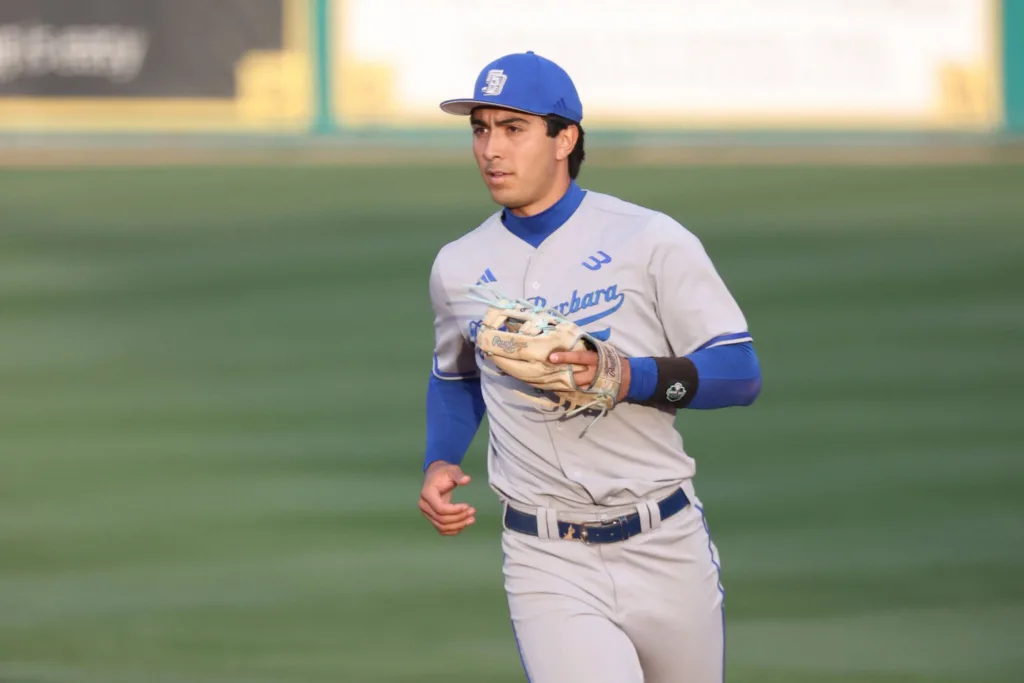While each player was on the outside looking in for our most recent 2026 college draft rankings, they all received strong consideration. As such, it’s not unreasonable to expect a handful to make their way onto the next iteration of the college top 100.
In what is usually the case with these kinds of pieces, it’s important to keep in mind that this is not a ranking. Players below are listed in alphabetical order.
Carson Bailey, LHP, Baylor
Bailey’s draft year was initially 2027, but he will now be eligible in 2026 after transferring to junior college powerhouse McLennan College (Texas). Bailey this spring was a stalwart within Baylor’s rotation—an impressive feat for any freshman at a Power Four program—and worked a 4.89 ERA with 56 strikeouts to 21 walks across 53.1 innings.
Bailey has an athletic frame with some present thickness in his lower half, though he still has room to fill out further. He works exclusively out of the stretch, has a long arm stroke and shows present arm speed while attacking out of a three-quarters slot. For his arsenal, Bailey features a fastball that averaged 93.4 mph, a low-to-mid-80s slider and a mid-80s changeup.
Bailey’s bread-and-butter pitches are his secondaries. He has demonstrated the ability to manipulate the shape of his slider, and it’s effective against both right and lefthanded hitters. Against lefties, it takes on more of a gyro look, though he has also shown the ability to back-foot it for whiffs. Against righties, it has two-plane tilt with more length than depth. Bailey’s changeup has also flashed above-average with late tumble. His slider and change generated miss rates of 39% and 35%, respectively. I’ll be curious to see how Bailey’s fastball quality progresses, as it’s below-average right now due to a dead zone profile, modest extension and a rather steep approach angle.
Bailey has a chance to be one of the first junior college players off the board next July.
Max Bayles, RHP, Santa Clara
Bayles enjoyed immediate success as a freshman in 2024 and posted a 3.40 ERA with 50 strikeouts to 16 walks across 42.1 innings. His first three appearances this spring came in relief, but he proceeded to join the weekend rotation and pitched to a 4.46 ERA with 105 strikeouts across 66.2 innings en route to a Team USA selection.
Bayles starts his motion with his body turned toward the third base side. His small sidestep leads into an average leg lift, and he attacks out of a high three-quarters slot with a bit of a head whack. Bayles’ bread-and-butter offering is his low-to-mid-80s slider. It’s his most-used pitch, and he’s comfortable throwing it in any count to both righthanded and lefthanded hitters.
Bayles threw his slider 48% of the time last season, and it’s a pitch for which he has an advanced feel. He’s shown the ability to manipulate its shape. Oftentimes, it takes on a sharp gyro look, but he can back-foot it to lefties and also have it take on more of a two-plane look with a bit of lateral break against righties. It generated a mighty impressive 52% miss rate last spring and held opposing hitters to a minuscule .156 average.
For as impressive as his slider is, Bayles’ fastball is more of a work-in-progress. It sits in the low 90s, but it’s not a bat-misser and doesn’t generate empty swings. It’s a high-spin pitch that will flash some life in the top third in the zone as well as run and sink at times. His above-average extension and average spin rate over 2,400 rpms are two positive traits, but Bayles will need to refine and optimize his heater’s shape.
Bayles’ fastball-slider combination accounted for 90% of his pitches thrown last season. He doesn’t have a true third pitch, but his mid-80s changeup flashes late tumble at times and looks the part of a potentially serviceable offering to round out his arsenal.
Lee Ellis, SS, Ohio State
After logging just 22 at-bats at South Carolina in 2024, Ellis decided to enter the transfer portal and take his talents to Ohio State. As the Buckeyes’ primary shortstop this past season, he hit .296/.408/.514 with six doubles, a pair of triples and seven home runs.
Tools are the name of the game here with Ellis, who this season flashed his exciting skill set on a regular basis. His athleticism is evident in the batter’s box, where he moves well and flashes easy plus bat speed. Ellis has a knack for creating leverage and back-spinning the baseball to the pull side, where he has borderline above-average power. His hit tool needs a coat of polish, particularly as it pertains to picking up secondaries out of the hand, but Ellis’ offensive profile is intriguing nonetheless.
On the dirt, Ellis is a high-level athlete who has quick feet and is comfortable both attacking the baseball and throwing from multiple arm slots. His game has come together nicely over the course of the last calendar year. On top of what there is to like now, Ellis has upside remaining and could be a top-five round selection next July.
Logan Hughes, OF, Texas Tech
Following a productive freshman season at Stetson in which he hit .292/.398/.515, Hughes entered the transfer portal and eventually committed to Texas Tech. In his first season as a Red Raider, he flourished to the tune of a .327/.411/.697 slash line with 13 doubles, 19 home runs and more walks (26) than strikeouts (24). Hughes wasn’t done there, though, as he put the cherry on top of the season that was with an all-star summer on the Cape.
While Hughes is slightly undersized—he’s listed at 5-foot-11 and 197 pounds—there’s no shortage of present strength and physicality. He has a simple operation in which he has a slightly crouched stance and medium-high handset. There are minimal moving parts in his swing, and Hughes does a nice job of keeping his head still throughout. He has plenty of bat speed and has shown the ability to drive the baseball with authority to all fields while consistently being on the barrel.
Hughes boasts a tantalizing hit-power combination and on top of his plus bat-to-ball skills—last spring, he posted an overall in-zone contact rate of 91%—his raw power also grades out as plus. He will sometimes expand the strike zone against secondaries down, but both his approach and swing decisions are advanced.
On top of his back of the baseball card stats, Hughes’ under-the-hood numbers are even more impressive. Last spring, his average and 90th percentile exit velocities were 94.4 and 106.7 mph, respectively, to go along with a hard-hit rate north of 60%. Defensively, Hughes profiles best in either left field or at first base professionally, but he still figures to be selected in a prominent spot next July thanks to his bat.
Carson Jasa, RHP, Nebraska
Jasa missed the entirety of the 2024 season and logged just 18.2 innings this spring, but he flourished this summer and was one of the more exciting prospects in the Cape Cod League. A towering 6-foot-7, 230-pound righthander, Jasa compiled a 4.67 ERA with 34 strikeouts to 25 walks across 27 innings (six starts) for Hyannis and flashed premium stuff.
Jasa has a high-waisted frame and attacks out of a high three-quarters slot with a deep, slingshot arm stroke. His high-spin fastball sat in the mid 90s and was up to 98 mph with solid carry in the top half of the zone. However, he struggled to locate it, and it didn’t generate a lot of whiffs.
Jasa’s calling cards are his two high-spin breaking balls. His upper-80s-to-low-90s power cut-slider hybrid is a pitch he spun in the 3,000 rpm range, and it consistently made hitters look silly, flashing sharp, late glove-side life with some depth. His upper-70s-to-low-80s curveball is distinct in shape and flashed sharp, downward tilt. The two pitches generated respective miss rates of 54% and 44% this summer. He completes his arsenal with a low-to-mid-80s split-change that, at times, will flash real fade to the arm side with a bit of tumble. For now, it’s a fine fourth offering.
Jasa’s command and control—or lack thereof—is a significant enough question mark to give him a decent amount of reliever risk. Keeping his delivery and long levers in sync has been a challenge, but when he’s in and around the strike zone, he can be flat-out dominant. Jasa’s upside is tantalizing, and this spring he has a chance to shoot up draft boards.
Camden Johnson, 3B, Oklahoma
A two-year standout at Wichita State, Johnson heads to Oklahoma on the heels of an impressive summer on the Cape in which he hit .292/.362/.354 with a league-leading 42 hits and 18 stolen bases. A top of the order sparkplug, Johnson’s exciting tool set allows him to impact the game in myriad ways.
With a wiry, athletic frame, Johnson stands tall in the box with a high handset. He is a small-strider with quickness in his hands, and there’s little-to-no wasted movement in his operation. Johnson will almost certainly always be a hit-over-power profile, but he uses the entire field and will occasionally drive the baseball into the pullside gap. He’s a comfortably plus runner who will regularly take an extra base on a ball in the gap or down the line. He’s also a nuisance on the base paths, where he’s an aggressive runner and effective basestealer.
This summer, Johnson handled third base, where he flashed an average, if not a tick above-average, arm. He has quick feet on the dirt and showed comfort attacking the baseball and throwing on the run. Johnson is unlikely to get much, if any, run in center this spring, but his speed and athleticism would both translate well in the outfield, and he could very well move to center field professionally.
A gamer in every sense of the word, Johnson’s high-energy style of play rubs off on all with whom he shares a dugout. The SEC will be a new challenge for him, but Johnson has a chance to be selected within the first five rounds in 2026.
Ryan Kucherak, SS, Northwestern
After logging just 12 at-bats as a freshman at LSU in 2024, Kucherak opted for a change of scenery and headed north to Northwestern. He was the centerpiece of the Wildcats’ lineup this spring and hit .289/.379/.639 with 12 doubles and a Northwestern single-season record 18 home runs. Kucherak has an athletic frame, and he stands fairly tall in the box with about an ear-high handset. While his toe tap leads into a somewhat lengthy stride, Kucherak has serious bat speed.
As it stands, Kucherak is undoubtedly a power-over-hit profile. He fares well against fastballs, and last spring, 19 of his 31 extra-base hits came against heaters while he chased at a 14% clip. But he struggles to pick up spin, which leads to both miss and chase. It was especially an issue this summer on the Cape, as he posted whiff rates over 40% against each type of secondary offering. However, if Kucherak is able to improve his ability to see shapes out of the hand—which is easier said than done—it will go a long way toward him achieving his offensive upside.
Like Hughes, Kucherak’s batted-ball data is mighty intriguing. On top of an average exit velocity over 94 mph, Kucherak’s 90th percentile EV was an impressive 107.2. He generated high-quality contact on a regular basis with fairly optimal launch angle numbers. It goes without saying, but the biggest key for Kucherak as he transitions into pro ball will be shoring up his hit tool.
As the everyday shortstop for Northwestern, Kucherak showed sound actions with an above-average arm, and he has a chance to stick at the position professionally. He has top-five round upside next July.
Ryan McKay, 2B, Michigan State
Whether at school or during the summer, all McKay has done throughout his college career is hit. After a career year in which he slashed .319/.421/.495 with 20 doubles, five home runs and 36 walks to 31 strikeouts, McKay enjoyed a standout summer on the Cape to the tune of a .300/.374/.354 line with seven doubles.
An undersized second baseman, McKay stands out for his hit tool. Standing tall in the box with an open front side and ear-high handset, he has a compact, contact-oriented stroke with quickness in his hands. McKay sprays line drives to all parts of the field and does a nice job of going with the baseball and hitting it where it’s pitched. His bat-to-ball skills are double-plus, and last spring he posted an overall in-zone contact rate of 95% to go along with a polished approach. While McKay’s power grades out as a 30, he has sneaky extra-base thump to the pull side. Nonetheless, his barrel awareness is advanced, and it’s rather easy to project on his hit tool translating in pro ball.
McKay is not a burner by any means, but he’s run well enough to be an effective basestealer throughout his career. He makes the plays that he should at second base, which is where he’ll stick defensively at the next level.
Jonathan Mendez, 2B/SS, UC Santa Barbara
Mendez showed flashes as a freshman in 2024, but he took his game to the next level this past spring and hit .314/.392/.559 with 17 doubles, 11 home runs and 40 RBIs. At 6-foot-1 and 200 pounds, Mendez has an average build with particular physicality in his lower half. He has an upright stance and wiggles his bat above his back shoulder pre-swing, which leads into a barrel tip as the pitcher breaks his hands. Mendez has thunderous bat speed and a pull-oriented approach, and he absolutely feasts on fastballs.
Last season, Mendez posted a .351/.442/.586 slash line and a 92% contact rate against all heaters. For as well as he fares against fastballs, though, he struggles to pick up spin out of the hand, which leads to both miss and chase against secondaries. He’s most susceptible to swing-and-miss against right-on-right sliders, particularly when they’re located down and/or away.
He’ll need to improve his hit tool, but Mendez’s batted-ball data is intriguing. He posted a 90th percentile exit velocity just under 105 mph to go along with solid marks in both hard hit rate (45%) and air pull rate (42.65%). Mendez has flashed above-average pullside thump, and getting more aggressive on pitches in his “nitro zone” will serve him well.
Mendez got some run at shortstop in both the spring and summer, during which time he showed solid hands and a serviceable arm. However, his actions likely profile best over at second base in pro ball, and he has a chance to be an average defender at the position.
Ryan Oshinskie, RHP, Brown
After posting a modest 6.06 ERA across 16.1 innings this spring, the summer served as a coming-out party for Oshinskie. Across 13 appearances (two starts) on the Cape that spanned 28 innings, the 6-foot-3 righthander pitched to a 1.93 ERA with a strikeout-to-walk ratio of 38-to-7.
Oshinskie has a projectable, reasonably high-waisted frame and works exclusively out of the stretch. He has a slightly deep arm stroke and attacks out of a three-quarters slot. His high-spin fastball sits in the low 90s and has been up to 95 mph with both run and ride, especially in the top half of the zone.
Oshinskie’s calling card, though, is a high-70s-to-low-80s changeup, which was one of the best of its kind on the Cape and is a no-doubt plus pitch. He’s comfortable throwing it against both righthanded and lefthanded hitters, and this summer it garnered gaudy miss and chase rates of 54% and 42%, respectively. Oshinskie’s confidence in the pitch is evident, and it routinely flashes ample tumble and fade.
He rounds out his arsenal with a pair of distinct breaking balls in a high-70s curveball and a mid-80s slider. The curve flashes both depth and some sharp, downward break, while his slider is shorter in shape with late and effective gloveside life.
An above-average strike-thrower with a true four-pitch mix, Oshinskie will have the chance to prove himself as a starter professionally.
Discover more from 6up.net
Subscribe to get the latest posts sent to your email.


